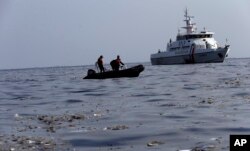The crash of a Lion Air jet carrying 189 people in Indonesia is again raising discussions about the country’s air safety, which once had a poor reputation but has improved markedly in recent years.
Just 13 minutes after taking off from the Indonesian capital of Jakarta to the city Pangkal Pinang in the Bangka-Belitung province, the Boeing 737 Max 8 — operating since August with an 800-hour airtime — went missing from the radar after the pilot requested to return to base. The plane crashed into the Java Sea Monday near Karawang, West Java.
Search and rescue team has been deployed in the waters, having found debris, belongings and 48 body bags containing body parts. The search for the black box, deemed to be the key element in looking for the reason why the plane crashed, is still underway, with ships and sonar system already deployed.
Data shown by the flight tracking service FlightRadar24 showed that the airplane had shown irregularities, noting “an increase of speed,” a “decrease in altitude and a “high rate of descent.”
The government wouldn’t directly comment for this story, but at a press conference Tuesday the Transport ministry said it has conducted an inspection on Lion Air’s eight other Boeing 737 Max 8 planes. “This is a form of a sanction, we’re inspecting the planes for clarification purposes to determine whether they’re good or faulty,” said Budi Karya, Indonesia’s transportation minister, in a press conference Tuesday.
According to Daniel Putut, Lion’s Air Managing Director, the investigation will perhaps take a week to complete and Lion Air is ready to “receive any sanction that’s given,” he said Tuesday in a press conference.
The crash is the worst since 1997 when a Garuda Indonesia airplane crashed into the mountains and killed 234 in total, leaving no survivors behind. An AirAsia flight went down in 2014, killing 162.
The latest tragedy has again brought to the fore questions on Indonesia’s aviation security.
Most of the problems, according to Geoffrey Thomas, the administrator of the website Airline Ratings, boil down to infrastructures. In 2004, a Lion Air airplane skidded off and overran the runway, killing 25, according to the Aviation Safety Network. “The safety of the infrastructure itself needs to be improved,” he said.
But aviation observer Alvin Lie says Indonesia has already had several improvements that qualify its air space for international standardization. It wasn’t always like this. In 2007, the European Union barred most Indonesia’s airlines from entering their soil, a ban that was partially lifted in 2009 and only fully lifted last June.
In 2016, the U.S. Federal Aviation Administration (FAA) lifted its 2007 ban and bumped Indonesia into category 1, allowing its airlines to enter the U.S..
Lie said Indonesia has reached international standards, including the quality of human resources, navigation infrastructures, quality of airports and search and rescue management.
“In the last four years, we have improved our air security,” he said.
The recent accident could be treated as “a mar on an otherwise better track record,” said observer Dudi Sudibyo. Sudibyo also referred to the International Civil Aviation Organization’s 2017 recognition of Indonesia’s achievements in “resolving safety oversight deficiencies and improving the effective implementation of ICAO Standards and Recommended Practices (SARPs).”
But more improvements are still necessary according to Lie.
Indonesia’s domestic traffic has ballooned from 30 million in 2005 to almost 97 million last year according to the consultancy group CAPA-Center for Aviation. Though noting that Indonesia is the world’s fifth largest domestic aviation market, it is still plagued by an “unfavorabl[e] regulatory environment and overcapacity.”
“Right now, airspace in Indonesia is overloaded, especially in Java,” Lie said. “We have to improve the capacity of our air navigation service. One more problem we have is on our technology.” In spite of all this, Lie also noted that “compliance [from airlines] is another matter.”
Lie said what is needed is a “Commitment from the government—many of the regulations have to be up to international par.”
Indonesia’s The National Transportation Safety Commission (KNKT) noted that the average of number of plane accidents every year in Indonesia is 28. According to its findings from 2007-2017, 572 fatalities were recorded. In 2016, the commission said that more than two-thirds of the accidents were caused by human error. The other causes included runway excursion, ground collision and more.








